Storytime Activity: The cubes shown here are made from 6” x 6” packing boxes. There are 6 sequences per cube, one for each side of the cube. You can see here a sequence of three for caterpillar to cocoon to butterfly and from pumpkin to carving a jack-o-lantern face, to the finished jack-o-lantern.To play, each family or small group gets three cubes as a set. A child rolls a cube and describes the picture. If the child is unable to respond, the adult helps the child reply or labels the picture with one word. Next, different people in the group look for other items in the sequence on the remaining two cubes. [For easier sequences use only two items, for harder sequences use four or more cubes.] Early Learning Aside: Talking about sequences, first, second, third, what happens next supports scientific and mathematical thinking with this cube activity. In this case we will be playing with sequences of three, three in a row. Talk together about the pictures and what pictures make sense to be in the sequence. Then line up the cubes in a row in order from left to right. [Note that a 1, 2, 3, sequence could be from less to more or more to less. It is still a sequence.] Continue the game as another person rolls a cube; repeat the process. Instructions to make and use the cubes: cubesseq
Too Tall Houses by Gianna Marino
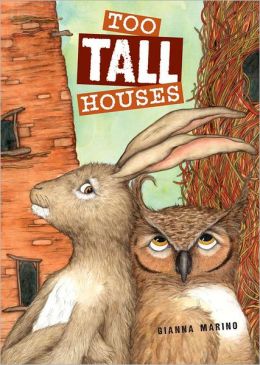
Early Literacy Aside--Explain: In today's storytime I will be pointing out ways you can support your children's background knowledge through talking about what is happening in a book and writing about it too. By asking children about the story, we help them thinking bout what is happening and help them better understand the story.
Introduction: Our next book is Too Tall Houses by Gianna Marino. There are two houses in this story, one for Rabbit and one for Owl and they get the two houses get too tall; they get very tall. In this story Rabbit and Owl have a problem. Let's see what that problem is and maybe you can give some suggestions on how to solve it.
Read the book to the page where Owl's house is blocking the sun that Rabbit needs for his garden, but Owl wants to see the forest. Ask an open-ended question such as "What do you think might happen?" "What do you think Rabbit and Owl could do solve their problem? Rabbit needs sun for his garden but his garden has grown tall and Owl wants to see the forest."
Early Literacy Aside--Example: Some stories, like this one, really lend themselves to helping your children think about how to solve problems. Asking them to stop and think about possible solutions develops their thinking skills which also helps with understanding. Remember there is no one right answer. It is good for them to think about different possibilities.
Early Literacy Aside--Empower: In our storytime today we read the story Too Tall Houses. There are several ways Rabbit and Owl might have solved their problem. Have your children draw their own ending to the story and write down what they say. This activity combines writing with problem solving to make for better comprehension now and as they learn to read themselves.
Peanut & Fifi Have a Ball by Randall de Seve

Introduction: When we use books that are fun and use imagination, our children make a connection to the story. In Peanut and Fifi Have a Ball written by Randall de Seve and illustrated by Paul Schmid, Peanut has a new ball and Fifi tries so hard to get her to play. Watch how this story uses a simple item and adds imagination.
Read the book.
Activity: Act out the story.
Early Literacy Aside--Example: Acting out the story, dramatic play, reinforces both the story itself and the pleasure about the story. By internalizing the story, they are better able to understand it.
Early Literacy Aside--Empower: I hope you'll encourage playing with stories at home as well. Take a box, ruler, blanket, ball, or many other simple items and use make believe to encourage play. Other books that work with Play and imagination are Not a Box and Not a Stick by Antoinette Portis. After playing with a simple item, you can always expand on this play by having your child draw something they did, dictate a story about their play, or just describe what they did with the item. Using writing to expand on the story validates your child’s play. Talking about and recording the story, going over the sequence is uses their narrative skills which helps your child learn how stories work by using first, next, and last. Submitted by Dianna Burt, Allen County (IN) Public Library
Five Little Monkeys Sitting in a Tree Song
Preparation: Use a crocodile hand puppet and five monkeys that can be removed from a glove puppet. If you have a tree prop, like one for Chicka Chicka Boom Boom, place monkeys on the tree.Children count and snap. Children of all ages enjoy the rhythm/chant of the song and the snapping. Adults with babies can gently give them a surprise snap with a big smile. Toddlers and preschoolers count and like the repetition.
Five little monkeys sitting in a tree (Hold up five fingers and bounce hand up and down)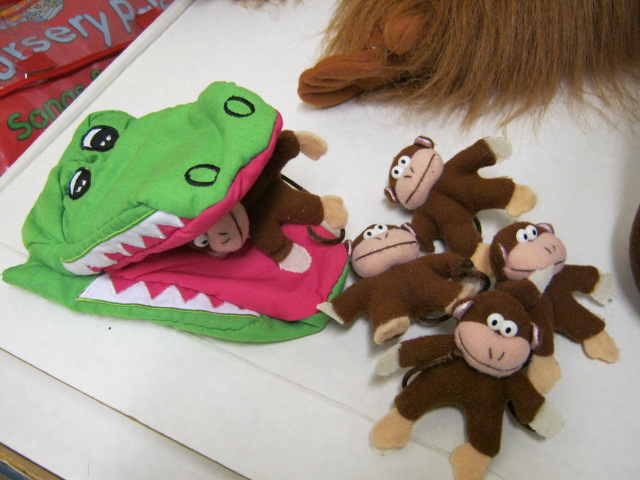 Teasing Mr. Crocodile, teasing Mr. Crocodile (Wave fingers forward)
Can’t catch me; can’t catch me. (Shake head no.)
Along comes Mr. Crocodile as quiet as can be. (Whisper with index finger over nose and mouth.)
And SNAPS that monkey out of the tree!
Teasing Mr. Crocodile, teasing Mr. Crocodile (Wave fingers forward)
Can’t catch me; can’t catch me. (Shake head no.)
Along comes Mr. Crocodile as quiet as can be. (Whisper with index finger over nose and mouth.)
And SNAPS that monkey out of the tree!
To make this rhyme more interactive between adults and children, when you repeat it, have the adult be the five little monkeys, holding up one hand. The child is the crocodile making a mouth with one hand. Optional: Reverse roles.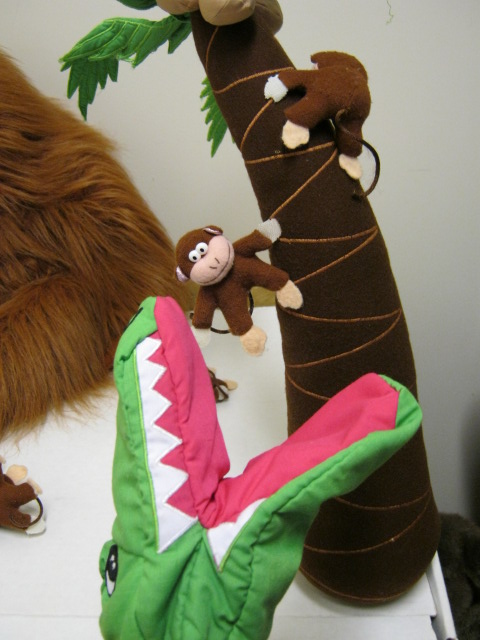
Early Literacy Aside--Example: In this rhyme, we are counting backwards with our children in a fun way. Counting is part of learning concepts which support your child's background knowledge.
Submitted by Katie Rinenbach, Bucks County (PA) Public Library
What! Cried Granny by Kate Lum
Early Literacy Aside--Explain: Our early literacy tip today is on print motivation, your children's enjoyment of books and reading. Children who have had positive experiences around books and reading before going to school are more likely to stick with learning to read even if it is difficult. I'll be pointing out some ways to make booksharing enjoyable in today's storytime. Book and flannel board: What! Cried Granny: An Almost Bedtime Story by Kate Lum is our next book. It's about a boy who is having a sleep-over at his grandmother's house. Let's see what happens when he tries to get the things he needs to go to sleep. Granny is often surprised and says in a loud voice,
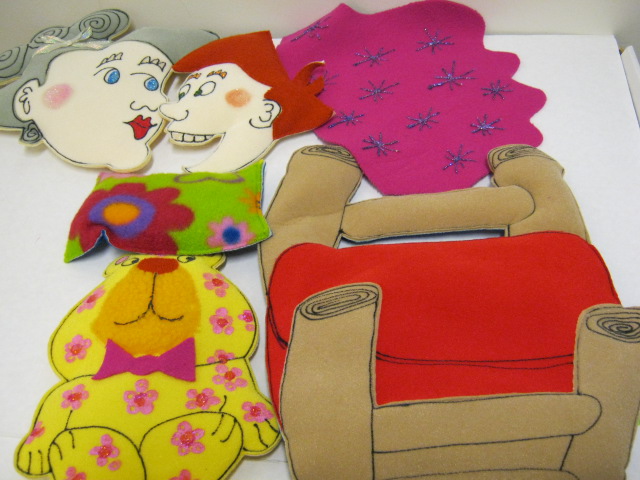
"What!" Let me hear you all say that. You can join in as we go through the story.
Early Literacy Aside--Example: There are many ways to have children participate in stories as we read together. Having them participate as we read the story helps them enjoy the story more.
Submitted by Katie Ringenbach, Bucks County (PA) Public Library
Rock a Bye Baby
Song as lead in to book: Rock a Bye Baby[Adults rock baby back and forth] Rock a bye baby on the tree top, When the wind blows, the cradle will rock. When the bough breaks the cradle will fall, And I'm there to catch you, cradle and all.
Early Literacy Aside--Example: When we sing to babies, they hear language slowed down which makes it easier for them to hear the sounds in words. Even thugh we may not sing to our children for this purpose, it is the beginning of helping them to later sound out words when they later learn to read.
Jane Klein, Chester County (PA) Library System
Five Scrumptious Cookies
We sing this song after reading Wolf's Chicken Stew by Keiko Kasza. The first time you come to the word scrumptious, add the words delicious or yummy. [If you prefer you can tlak about the word scrumptious before starting the book.]Early Literacy Aside--Example: When a book has a word that is unfamiliar to your child, this is a great opportunity to build vocabulary. Don't replace the word with a simpler one, just explain it briefly. Books have rich language, more unusual words than we use in daily conversation. Five Scrumptious Cookies Five scrumptious cookies in the baker’s shop Big and round with some sugar on top Along came a boy with a penny to pay Who bought a scrumptious cookie and took it away.
Four scrumptious cookies . . . Three scrumptious cookies . . . Two scrumptious cookies . . . One scrumptious cookie . . . No scrumptious cookies . . . Big and round with some sugar on top No one came with a penny to pay. So close the baker’s shop and have a baking day.
Llama, Llama Time to Share by Anna Dewdney
Read Llama, Llama Time to Share by Anna Dewdney.Point out some word pairs that rhyme, such as boat and moat. Ask children what other words rhyme with boat (they don't have to make sense). Early Literacy Aside--Example: Helping children hear words that rhyme is one way to help them hear the smaller sounds in words which will then later help them sound out words. storytimehandoutlorenasearsPA Early Literacy Aside--Empower: I have a handout for you with suggestions for some rhyming games and ways to help your children hear the smaller sounds in words. Lorena Sears, F D Campbell Memorial Library (PA)
Breakfast for Jack by Pat Schories
Our next book is a wordless book. It has pictures but no written words. Let's see if you can figure out what the story could be just from the pictures. Read through Breakfast for Jack by Pat Schories (or another wordless book of your choice) Let the children contribute to the conversation as you go through the pictures in the book.
Early Literacy Aside--Example: Using wordless books and having your child tell the story is one easy way to develop your children's narrative skills--having them tell stories. They can tell the story different ways when reading the book several times.
Early Literacy Aside--Empower: I have displayed some wordless books today. Feel free to check them out and have your children tell you the story. If they seem to be stuck, you can ask open-ended questions like "What do you see in this picture? What do you think is happening here?" If you are telling the story together, remember to follow your child's lead. Supporting your children's narrative skills helps them later understand what they read.
Read through Breakfast for Jack by Pat Schories (or another wordless book of your choice) Let the children contribute to the conversation as you go through the pictures in the book.
Early Literacy Aside--Example: Using wordless books and having your child tell the story is one easy way to develop your children's narrative skills--having them tell stories. They can tell the story different ways when reading the book several times.
Early Literacy Aside--Empower: I have displayed some wordless books today. Feel free to check them out and have your children tell you the story. If they seem to be stuck, you can ask open-ended questions like "What do you see in this picture? What do you think is happening here?" If you are telling the story together, remember to follow your child's lead. Supporting your children's narrative skills helps them later understand what they read.
Little Red Hen Readers' Theater
Introduce the book Little Red Hen by Byron Barton: This is a folktale that many authors have retold. The book we are going to read was written and illustrated by Byron Barton. [Have several copies of the book available, or copied sheets.] Today with your help, we are going to read by doing what is called Readers' Theater. This is playacting without having to memorize any lines. I will act as narrator, but I will need the rest of you to participate as well. Let's divide into three groups: pig, duck, and cat. Now I will need four parent volunteers and your children to come to the front to read the lines of the characters. After you have read the lines, encourage the children to repeat after you. After the child says your words then the children in groups will say those words as well.Clap for all the participants--children in groups, children up front, parents. Talk briefly about the story by asking questions such as How would you feel if you were the little red hen? What would you have done? What do you think the pig, duck and cat might do next time? Early Literacy Aside--Example: When you have children act out stories, it is not only fun, but this kind of dramatic play helps them understand how stories work and helps them understand the story. These are skills that will help them understand what they read when they get to school. Lillie Butler, St. Tammany Parish (LA) Library
Song in Spanish
Here is a song that is fun to sing in English, Spanish or both, to the tune of "Frere Jacques."Esta canción es divertida cantar en inglés, español, o ambos, al tuno de "Frere Jacques."
Hello children. Hola niños. How are you? ¿Como están? Very well thank you. Muy bien gracias. How about you? ¿Y Usted?
Although today we are having fun singing songs in two languages, talk with your children in the language that is most comfortable for you. It is best for children to know one language spoken fluently. If children know one language well, they can learn another one more easily. If you are fluent in more than one language you can choose which language to talk with your child in.
Aunque hoy nos divertimos por cantar en dos idiomas, recuerde hablar con sus niños en el idioma que usted mejor sepa. Es mejor para los niños saber un idioma con fluidez. Si los niños saben bien un idioma, es más fácil para ellos aprender otro. Si usted habla con fluidez más que un idioma, puede elegir en cual quisiera hablar con su niño.
by Katie Cunningham, http://bilingualchildrensprogramming.blogspot.com
Library Love Song
Library Love Song[Storytime presenter] I love you, you love me We're a happy library With a great big hug And a wish from me to you Won't you say you'll read books, too!
[Child to adult/parent] I love you, you love me Won't you share a book with me? With a great big hug And a wish from me to you Won't you say we'll read books, too!
Early Literacy Aside--Example: Keeping that close connection as we read with children is something they cherish. It is this kind of feeling around reading books that helps them see reading as something enjoyable. This attitude helps them want to hear more books, read more and makes learning to read easier.
Jane Boss, Hennepin (MN) Public Library and Diana Price, Bucks County (PA) Free Library
B I N G O (Bingo) Song
BINGO SongHere is a way to do the BINGO song so that we are saying all the letters at the end. "X" means to clap. There was a farmer had a dog and Bingo was his name oh, B-X-X-X-X, B-X-X-X-X, B-X-X-X-X And Bingo was his name, oh. There was a farmer had a dog and Bingo was his name oh, B-i-X-X-X, B-i-X-X-X, B-i-X-X-X And Bingo was his name, oh. There was a farmer had a dog and Bingo was his name oh, B-i-n-X-X, B-i-n-X-X, B-i-n-X-X And Bingo was his name, oh. There was a farmer had a dog and Bingo was his name oh, B-i-n-g-X, B-i-n-g-X, B-i-n-g-X And Bingo was his name, oh. There was a farmer had a dog and Bingo was his name oh, B-i-n-g-o, B-i-n-g-o, B-i-n-g-o And Bingo was his name, oh. We all spelled Bingo's name. You know all these letters! B i n g o (point slowly to each one) Early Literacy Aside--Example: Singing letters of the alphabet is one enjoyable way for children to learn letters. You can spell out other words using the same tune. Having children become familiar with letter names and identifying letters will later help them as they try to recognize words.
Eensy Weensy Spider by Mary Ann Hoberman
During the storytime, introduce book: Our next book is called The Eensy Weensy Spider. It has the eensy weensy spider rhyme that we are familiar with. Let's say it together (show first page). Now the author, Mary Ann Hoberman, has made up some new verses. I'll read you one of my favorite ones: The eensy weensy spider fell down and scraped her knees.
"Ouch!" cried the spider. "I need some Band-Aids, please!"
"How many?" asked her mama. "I only have a few."
Said the eensy-weensy spider, "Six of them will do."
The eensy weensy spider fell down and scraped her knees.
"Ouch!" cried the spider. "I need some Band-Aids, please!"
"How many?" asked her mama. "I only have a few."
Said the eensy-weensy spider, "Six of them will do."
Optional--talk about how many legs/knees a spider has . . . Early Literacy Aside--Explain: All of these rhymes based on the original, piggyback rhymes, have new rhyming word combinations. Pointing out the rhyming words or letting your children fill in a rhyming word helps them hear the smaller sounds in words which will help them later to sound out words when they learn to read. Early Literacy Aside--Empower: You noticed that today we read a bok with piggyback rhymes. You and your children can pick a rhyme they know well and then make up your own words to new rhymes. Having your children think of rhyming words is one way to support phonological awareness, hearing the smaller sounds in words. This is a fun activity and also helps your children later to sound out words. Enjoy!
Ready for Anything by Keiko Kasza
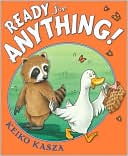
Submitted by Sophie Bruno, Sacramento (CA) Public Library
Big Chickens by Leslie Helakoski
 Book Introduction: Our next book is one of my favorite books called Big Chickens by Leslie Helakoski. There are three chickens and each of the chickens here is holding one of the letters for the word "big". Here is a B and an Iand a G.
Read the book.
Early Literacy Aside--Example: From time to time it is fun to point out letters as I did with the word BIG. You don't need an alphabet book to talk about letters.
Early Literacy Aside--Empower: Did you know that when your child plays with shapes or blocks and you talk about the shapes you are preparing them to learn to recognize letters!
Book Introduction: Our next book is one of my favorite books called Big Chickens by Leslie Helakoski. There are three chickens and each of the chickens here is holding one of the letters for the word "big". Here is a B and an Iand a G.
Read the book.
Early Literacy Aside--Example: From time to time it is fun to point out letters as I did with the word BIG. You don't need an alphabet book to talk about letters.
Early Literacy Aside--Empower: Did you know that when your child plays with shapes or blocks and you talk about the shapes you are preparing them to learn to recognize letters!
Submitted by Diane Christensen, Sacramento (CA) Public Library
Shapes Around Us by Daniel Nunn
Early Literacy Aside--Explain: Children learn to recognize letters by their shapes. Today I'll be pointing out some ways you can support letter knowledge by talking about shapes. During the storytime read Shapes Around Us by Daniel Nunn. Early Literacy Aside--Example: This book helps us think of so many shapes we see in the world around us. What a great way to help children notice shapes which later helps them recognize letters! Early Litearcy Aside--Empower: Pointing out and playing with shapes helps children to recognize and draw letters. Be sure to include both the upper cas and lower case versions of letters.
Don't Let the Pigeon Drive the Bus by Mo Willems
 Read the book Don't Let the Pigeon Drive the Bus by Mo Willems. Then flip back to a page with big angry font and read it in an angry tone of voice while pointing to the words.Early Literacy Aside--Example: Parents, here you can see how the text is reflecting the meaning of the words. From time to time, pointing to the words and having your voice reflect what is being said, or how it is said, helps children understand the meaning of what is going on. In this way you are supporting both print awareness and comprehension.
Read the book Don't Let the Pigeon Drive the Bus by Mo Willems. Then flip back to a page with big angry font and read it in an angry tone of voice while pointing to the words.Early Literacy Aside--Example: Parents, here you can see how the text is reflecting the meaning of the words. From time to time, pointing to the words and having your voice reflect what is being said, or how it is said, helps children understand the meaning of what is going on. In this way you are supporting both print awareness and comprehension.
Laura, Sacramento (CA) Public Library
Goodnight Moon by Margaret Wise Brown
 Early Literacy Aside--Example: You can use unfamiliar words with your children and model what they mean. For example, you can whisper when reading "whispering" and have your child say a quiet, "hush." This is a simple way to expand the words your children know. Let's try it as we read Goodnight Moon.Read Goodnight Moon by Margaret Wise Brown
Early Literacy Aside--Example: You can use unfamiliar words with your children and model what they mean. For example, you can whisper when reading "whispering" and have your child say a quiet, "hush." This is a simple way to expand the words your children know. Let's try it as we read Goodnight Moon.Read Goodnight Moon by Margaret Wise Brown
Cars Galore by Peter Stein
Video clip demonstration of an example early literacy aside emphasizing vocabulary using the book Cars, Galore by Peter Stein.
Click here
Saroj Ghoting, Early Childhood Literacy Consultant

